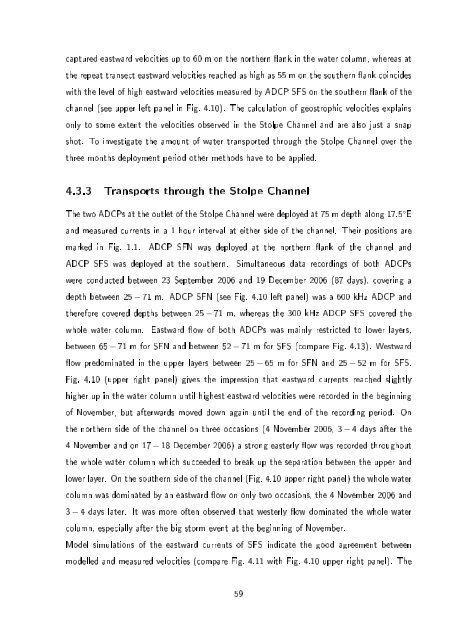Baltic Sea
Baltic Sea
Baltic Sea
Create successful ePaper yourself
Turn your PDF publications into a flip-book with our unique Google optimized e-Paper software.
captured eastward velocities up to 60 m on the northern ank in the water column, whereas at<br />
the repeat transect eastward velocities reached as high as 55 m on the southern ank coincides<br />
with the level of high eastward velocities measured by ADCP SFS on the southern ank of the<br />
channel (see upper left panel in Fig. 4.10). The calculation of geostrophic velocities explains<br />
only to some extent the velocities observed in the Stolpe Channel and are also just a snap<br />
shot. To investigate the amount of water transported through the Stolpe Channel over the<br />
three months deployment period other methods have to be applied.<br />
4.3.3 Transports through the Stolpe Channel<br />
The two ADCPs at the outlet of the Stolpe Channel were deployed at 75 m depth along 17.5 ◦ E<br />
and measured currents in a 1 hour interval at either side of the channel. Their positions are<br />
marked in Fig. 1.1. ADCP SFN was deployed at the northern ank of the channel and<br />
ADCP SFS was deployed at the southern. Simultaneous data recordings of both ADCPs<br />
were conducted between 23 September 2006 and 19 December 2006 (87 days), covering a<br />
depth between 25 − 71 m. ADCP SFN (see Fig. 4.10 left panel) was a 600 kHz ADCP and<br />
therefore covered depths between 25 − 71 m, whereas the 300 kHz ADCP SFS covered the<br />
whole water column. Eastward ow of both ADCPs was mainly restricted to lower layers,<br />
between 65 − 71 m for SFN and between 52 − 71 m for SFS (compare Fig. 4.13). Westward<br />
ow predominated in the upper layers between 25 − 65 m for SFN and 25 − 52 m for SFS.<br />
Fig. 4.10 (upper right panel) gives the impression that eastward currents reached slightly<br />
higher up in the water column until highest eastward velocities were recorded in the beginning<br />
of November, but afterwards moved down again until the end of the recording period. On<br />
the northern side of the channel on three occasions (4 November 2006, 3 − 4 days after the<br />
4 November and on 17 − 18 December 2006) a strong easterly ow was recorded throughout<br />
the whole water column which succeeded to break up the separation between the upper and<br />
lower layer. On the southern side of the channel (Fig. 4.10 upper right panel) the whole water<br />
column was dominated by an eastward ow on only two occasions, the 4 November 2006 and<br />
3 − 4 days later. It was more often observed that westerly ow dominated the whole water<br />
column, especially after the big storm event at the beginning of November.<br />
Model simulations of the eastward currents of SFS indicate the good agreement between<br />
modelled and measured velocities (compare Fig. 4.11 with Fig. 4.10 upper right panel). The<br />
59



